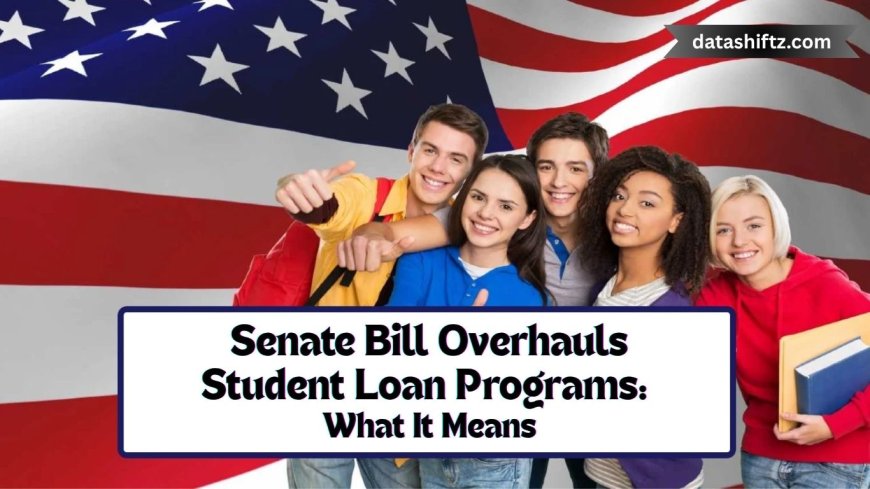Senate Bill Overhauls Student Loan Programs: What It Means

The U.S. Senate is rapidly advancing a sweeping student‑loan and education reform package as part of the broader “One Big Beautiful Bill Act,” targeting passage by July 4, 2025. With roots in House proposals and bipartisan input, it aims to redefine who borrows, how they repay, and protection for student borrowers—including major changes to Pell Grants, income‑driven repayment, borrowing limits, and forgiveness provisions.
What the Bill Proposes: Student‑Loan Provisions
1. Borrowing Caps & PLUS Loan Elimination
-
Graduate borrowing limits: Capped at $100 k total, or up to $200 k for professional degrees (like MD/JD).
-
Parent PLUS loans: Eliminated or capped at $65 k per child.
-
Undergraduate limits: Remain unchanged—$31 k for dependents, $57.5 k for independents.
2. Income‑Driven Repayment Overhaul
-
All current income‑driven plans (e.g., SAVE, PAYE, REPAYE) would be phased out for new disbursements after July 1, 2026.
-
Two new plans:
-
Standard Repayment: 10–25 year fixed‑payment schedule.
-
Repayment Assistance Plan (RAP): Payments based on 1–10% of income, min. $50/month, forgiveness after 30 years.
-
3. Forgiveness & Borrower Protection Rollbacks
-
Deferred protections removed: Borrower defense, closed‑school discharge, hardship/unemployment deferments all discontinued.
-
PLUS loans phased out: Graduate PLUS loans eliminated, unsubsidized Stafford capped $20 k/year; Parent PLUS capped $20 k/year.
4. Pell Grant & Aid Changes
-
New eligibility constraints: families above autore threshold or students with full-ride scholarships may lose Pell .
-
Full-time enrollment definition may rise (e.g., from 12 to 15 credits).
Student‑Loan Impacts at a Glance
| Provision | Current System | Senate Bill Proposal |
|---|---|---|
| Graduate & Professional Loan Caps | $138.5 k aggregate, unlimited PLUS | $100 k total; professional programs up to $200 k total |
| Parent PLUS Loans | Unlimited, based on cost of attendance | Eliminated or capped at $65 k per student/year |
| Repayment Plans | Standard + ~8 income-driven options | Standard & RAP only (1–10% income, $50 min, forgiveness in 30 years) |
| Forgiveness Options | Forgiveness after 20–25 years, borrower defense | Forgiveness after 30 yrs; rescinds defense & discharge protections |
| Pell & Grant Eligibility | Broad eligibility for low-income students | Restrictions on full-ride scholars and higher-income families |
5. Why This Is a Game‑Changer
-
Fewer choices, higher risk
Students lose flexibility; higher minimum payments and narrower forgiveness mean greater financial strain. -
Private loans likely fill gaps
With tighter federal borrowing, students may turn to private lenders—featuring higher rates and fewer protections. -
Disproportionate impact on minorities & low‑income students
Capping borrowing could disproportionately affect students in minority-serving, lower-ranked professional programs. -
Student protections erode
Removing borrower‑defense and deferment opens more students to predatory institutions without recourse.
Major Features & Impacts
-
Caps on borrowing
-
Grad students: $100 k total; professionals: up to $200 k
-
Parent PLUS: $65 k limit or elimination
-
-
Repayment revisions
-
Eliminates PAYE, REPAYE, SAVE; offers only Standard and RAP
-
RAP = 1–10% of income, $50 minimum, 30‑year forgiveness
-
-
Protection rollbacks
-
Eliminates borrower defense, closed‑school discharge, deferments
-
-
Aid restrictions
-
Pell disqualified for full‑ride recipients, caps under income thresholds
-
-
Equity concerns
-
Wealthier, non-minority borrowers affected less; minority & low-income hit hardest
-
-
Shift to private lending
-
Caps force more to private loans—higher costs, fewer safeguards
-
What’s Next?
-
Senate vote impending: expected soon, likely under reconciliation rules requiring a simple majority.
-
House review ahead: already passed GOP version; differing provisions may be reconciled in conference.
-
Public response: advocates warn biased burdens; borrowers fear higher default risks and less protection.
-
Court challenges looming: repeals of borrower protections and fingerprinting of repayment plans could prompt legal actions.
Final Thoughts
The Senate bill clearly aims to “simplify” the student loan system, but at a steep cost: reduced flexibility, fewer protections, and renewed reliance on private lending—especially for underserved students. If you’re in school or managing loans, it’s vital to stay informed. These changes could reshape your repayment path—and your life—by mid‑2026. Stay tuned as Congress votes and refinements are made.





























